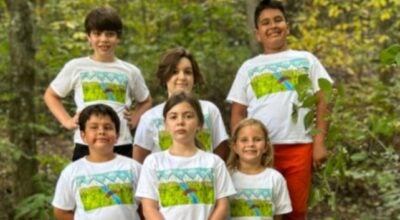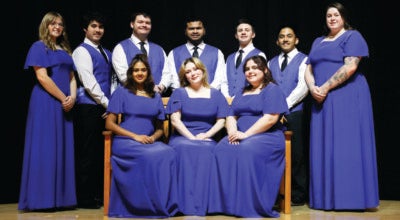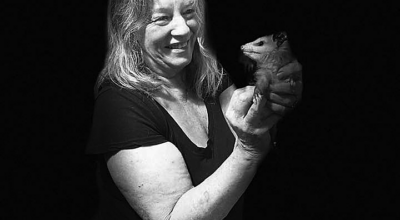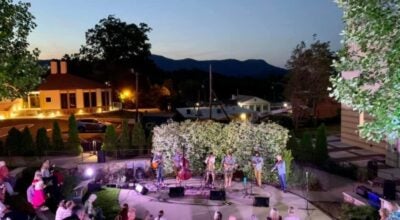Martine House crafting fine art from fabric, fiber
Published 3:42 pm Thursday, March 6, 2008
I am known in town mostly for my quilt work. The most visible example is the quilt commissioned as a donation to Hospice. I was given swatches to match the colors of the space where it hangs.
I like to use the two layer older French Marseille style. This embroidery style dates back to the 17th century, when it was used in clothing. The shoulder piece on this vest is an example. It is similar to the Boutis style familiar to more people, but the Marseille style includes openwork and the use of beads.
I like to take old traditional techniques and use them in new contemporary styles to link the past and the future.
Do you have a plan when you create a piece?
Most often with my two dimensional work there is a plan. Once in a while I am inspired by the color or texture of fabric, but most of the time I have an idea. A critic once described a piece of mine as a fine example of &dquo;conceptual art.&dquo; Basically my work expresses an idea and usually I have created a detailed sketch or plan. Things happen while I work and sometimes a mistake can be serendipitous in how it changes the plan. I have to leave some decision making for during the process or I get bored if it&squo;s all planned out from the beginning.
How did you learn to do this?
I always did things and in my family my grandmothers knitted and embroidered. Dad excelled at the artistic part of imagining something and problem solving to make it happen. So I learned that from him.
I met my husband in Germany and after we had a baby and moved to the United States someone gave me a book on quilting. I taught myself using the book and then took many workshops and classes. I learned beading and embroidery on my own. I have a hard time reading patterns, so if I make my own designs I don&squo;t have to follow anyone else&squo;s instructions.
Also, I have been teaching, which forces me to master what I teach. I won&squo;t teach something I&squo;m not comfortable with doing myself. I have learned a lot just interacting with my students.
Recently I have started hand dyeing fabric and threads. I still buy some of the hand dyed fabrics I use from Nancy Bruce in Landrum, who is a wonderful artist with an incredible sense of color.
I received a Henderson County Regional Artist grant to take a dyeing workshop in June. I&squo;m always learning new things because sometimes I can&squo;t quite get the color I envisioned. I also want to learn metalsmithing and woodworking beyond the realm of fabric.
Now that I&squo;m hand dyeing fabric I have a lot of fabrics for quilting that aren&squo;t being used. I donated a good portion of these to artists who lost their materials during Katrina.
What are you working on now?
My newer pieces are a hanging style such as this piece &dquo;Un Autre Monde&dquo; (&dquo;Another World&dquo;). In quilt shows there is importance placed on bold work with immediate impact. However, my trademark is secrecy and little pockets. You must get close to see the details and hidden features. In this piece the back drape is quilted, but the layers hanging in front use a variety of textures such as hand dyed wool roving (fiber that has not been spun into thread), velveteen, and silk accented with beads. There is even some puff paint that must be used carefully because it can burn the fabric. Mistakes force me to be creative. They usually end up being good things.
For &dquo;Family Entanglement&dquo; I started with the idea that family is wonderful, beautiful, and precious, but can be overwhelming and oppressing. I typed into the computer every word I could think of about family and
then printed on the fabric. In the final piece the fabric is pleated and hidden so I know the words are there, but you can&squo;t really read them.
This piece with the texture created using beads, thread, stitching various types of fabric reminds me of the heart muscle.
I had to problem solve to create the 3-dimensional structure, so wire was sewn underneath to make this possible.
I notice this &dquo;teaching example&dquo; has a bit of feather, and what is this textured layer?
I&squo;m always using different techniques to experiment with fabric and I had used a paper towel to clean up an ink spill. The color was so pretty when it dried that I decided to use it over the lace and plastic canvas. I collect things like the feathers, beads, and crystals because there is always a use for them.
Here is a piece that is about to be shipped to California titled &dquo;Reliquary.&dquo;
I see what might be a moss covered box, except it&squo;s all types of fabrics and beads creating the look. At the center there is what appears to be an old rusted metal clasp that opens to reveal a lovely tea dyed silk interior graced with fine hand embroidery around a window revealing a real leaf held in the center of the box. Along the sides are words printed on the fabric.
How do you print on fabric? Do you use a special printer?
I stabilized the fabric by ironing it onto freezer paper and then run it though an ink jet printer if I need color or a laser printer for just black.
My newest series are these little &dquo;Offerings,&dquo; little precious things containing a secret such as &dquo;Welcoming the New Dawn&dquo; or &dquo;Serenity.&dquo;
As I explore them, what appears on the outside to be velveteen boxes open to contain inside a beautiful landscape created with hand dyed silks detailed with beads and embroidery. Each piece contains a jewelry treasure as well.
&dquo;Well Grounded&dquo; is based on a piece of driftwood given to her by a friend that is wrapped in a bead embroidered necklace which when removed reveals beautiful needle felting, roving and bead work in the center of the wood that stands as its own piece of art.
I want to know about this flower!
It&squo;s called Bellicosa Angelica. Bill Crowell created the stand for the flower in this 3-dimensional piece. I wanted to represent the two personalities that many of us show. The outside that is bold and aggressive, while the inside is more intricate.
Sure enough the bright red petals held together by metallic beads pull apart to reveal a pale peach interior housing an intricate beaded necklace.
How long does it take to create these &dquo;Offerings?&dquo;
&dquo;Welcoming the New Dawn&dquo; took 65 hours. The piece I am working on now, &dquo;Matera,&dquo; already has over 100 hours in it, not counting the time spent thinking about it.
While &dquo;Matera&dquo; includes similar elements in its structure and composition to the other &dquo;Offerings,&dquo; it adds a special scent bowl, more hidden pockets, shisha mirrors to reflect bad spirits and exquisite silk ribbon embroidered roses and gold work.
When it&squo;s finished there will be earrings and a necklace for this piece. It&squo;s difficult to sell because of the time I put into it. So it may take some time to find the right market, or my children will inherit them.
It took a long time to consider myself an artist, not just a quilter or crafts person. I&squo;m not thinking about the sale or what to do with them. I just have to make them.
You can see more of Martine&squo;s creations in full color on her website at housefiber.com or contact her directly about the availability of her artwork and workshops by phone 828-894-5139 or email housefiber@hotmail.com.





